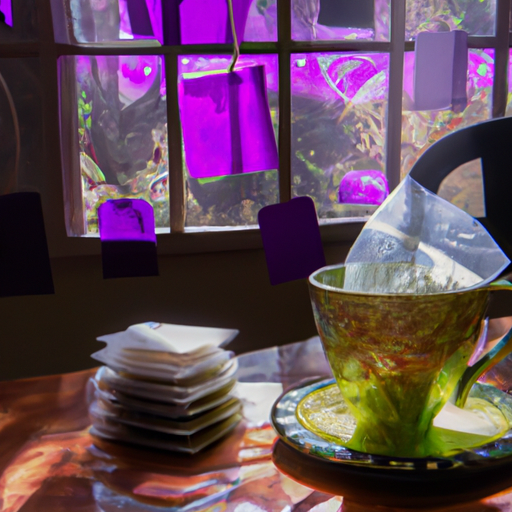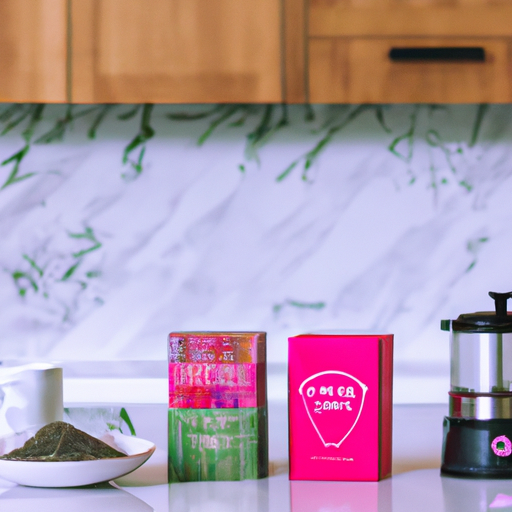As I sit here, savoring the rich aroma of a steaming cup of Yogi tea, I am reminded of the comfort and warmth it brings to my soul. There is something truly magical about this ancient blend of spices and herbs, carefully crafted to awaken the senses and nourish the body.
In this article, I will guide you through the art of making Yogi tea, sharing with you the secrets and techniques that have been passed down through generations. With just a few simple ingredients and a little patience, you too can create a cup of this divine elixir that will transport you to a place of tranquility and inner peace.
So join me on this journey as we explore the steps to making Yogi tea, and discover the joy that comes from brewing your own blend of aromatic spices. Get ready to awaken your senses and indulge in the soothing embrace of Yogi tea.
Key Takeaways
- Yogi tea offers numerous benefits, including reducing stress, promoting relaxation, boosting the immune system, and having anti-inflammatory properties.
- Enhancing the flavor of Yogi tea can be achieved by experimenting with variations and additions such as adding citrus fruits, sweetening with honey or maple syrup, and adding spices like cinnamon or nutmeg.
- Yogi tea can be customized according to individual preferences by trying different spice combinations, enjoying with citrus fruits, honey, and spices, and enhancing with dried rose petals or lavender buds.
- Enjoying Yogi tea not only provides a fulfilling tea experience but also offers a flavorful and satisfying drink with a refreshing and zesty citrus burst, unique blend of sweet and spicy flavors, delicate and fragrant floral infusion, and adds excitement to the routine while bringing enjoyment and well-being.
Gather Your Ingredients and Equipment
Gather all of your ingredients and equipment, like a cozy teapot and fragrant spices, to create the perfect atmosphere for making your delicious Yogi tea. When it comes to the type of tea to use, there are several options to consider. Traditional Yogi tea is made with black tea, but you can also experiment with green tea or even herbal blends for a unique twist. Each type of tea will impart its own distinct flavor, so choose according to your preference.
In addition to tea, you’ll need a variety of spices to create the signature Yogi tea taste. The most common spices used include cinnamon, cardamom, ginger, cloves, and black pepper. These spices not only add depth and warmth to the tea but also provide numerous health benefits. Feel free to adjust the spice ratios to suit your taste preferences.
When it comes to sweetening your Yogi tea, there are alternatives to traditional sugar. You can try using honey, maple syrup, or stevia for a healthier option. These alternatives add a touch of sweetness without overpowering the flavors of the spices.
Now that you have gathered all your ingredients, it’s time to move on to preparing the spice blend.
Prepare the Spice Blend
Mix together the various spices to create a fragrant and flavorful blend for your homemade brew. When it comes to making Yogi tea, the spice blend is what gives it its distinct taste and aroma.
There are endless possibilities when it comes to the combination of spices you can use, allowing you to personalize your brew to suit your taste preferences. Here are a few different spice combinations to try in Yogi tea:
-
Cinnamon, cardamom, cloves, ginger, and black pepper: This classic blend provides a warm and comforting flavor that’s perfect for chilly days.
-
Fennel seeds, coriander seeds, cinnamon, ginger, and cloves: This combination adds a slightly sweet and spicy twist to your tea.
-
Star anise, cinnamon, black pepper, cloves, and cardamom: This blend offers a unique and exotic flavor profile.
When preparing your spice blend, feel free to adjust the amounts of each spice to suit your taste preferences. You can experiment with different ratios until you find the perfect balance.
Once you have your spice blend ready, you can move on to the next step of boiling the water and adding the spices, infusing your tea with all those wonderful flavors.
Boil the Water and Add Spices
Start by bringing the water to a boil and then add in your carefully crafted spice blend, allowing the flavors to infuse and create a tantalizing aroma that’ll transport you to a world of cozy comfort.
When making yogi tea, there are various types of spices that can be used to enhance the flavor and provide additional health benefits. Some common spices include cinnamon, cardamom, ginger, cloves, and black peppercorns. Each spice adds its own unique taste and therapeutic properties to the tea.
Cinnamon, for example, not only adds a warm and sweet flavor but also helps to regulate blood sugar levels and reduce inflammation. Cardamom, on the other hand, adds a refreshing and slightly citrusy taste, while also aiding digestion and promoting detoxification. Ginger adds a spicy kick and is known for its ability to soothe the stomach and relieve nausea. Cloves provide a rich and aromatic flavor, as well as have antimicrobial and anti-inflammatory properties. Lastly, black peppercorns add a subtle heat and help to enhance the absorption of nutrients in the body.
Drinking yogi tea regularly can have numerous benefits. It can support digestion, boost the immune system, improve circulation, and provide a calming effect on the mind and body. The combination of spices in yogi tea creates a holistic blend that nurtures both the physical and emotional well-being.
Now that the water’s infused with the spice blend, it’s time to move on to the next step: steeping the tea.
Steep the Tea
Once the aromatic blend has permeated the water, allow it to sit and meld together, unlocking a symphony of flavors that’ll transport you to a state of pure bliss. Steeping the tea is a crucial step in the process of making Yogi tea, as it allows the flavors to fully develop and infuse into the hot water.
When it comes to choosing the type of tea to use for steeping, there are several options that can enhance the taste and aroma of your Yogi tea. Green tea, with its delicate and refreshing flavor, is a popular choice. Black tea, on the other hand, provides a stronger and more robust taste. Herbal teas, such as chamomile or peppermint, can add a soothing and calming element to your Yogi tea.
To achieve the perfect steeping time, it’s important to follow the instructions provided on the tea packaging. Generally, steeping times can range from 2 to 5 minutes, depending on the type of tea and personal preference. For a stronger flavor, you can extend the steeping time, but be cautious not to oversteep, as it may result in a bitter taste.
Now that the tea has steeped to perfection, it’s time to move on to the next step of straining and sweetening to taste. This process ensures that any tea leaves or spices are removed from the liquid, resulting in a smooth and enjoyable cup of Yogi tea.
Strain and Sweeten to Taste
After the tea’s steeped, it’s time to strain out any remaining ingredients and add a touch of sweetness to create a truly indulgent and comforting experience.
Straining the tea is an important step to remove any loose spices, tea leaves, or other ingredients that may have been left behind during the steeping process. I like to use a fine-mesh strainer or a cheesecloth to ensure a smooth and clear tea.
Now, let’s talk about sweeteners. Yogi tea can be enjoyed with a variety of sweeteners, depending on your preference. Some popular options include honey, agave nectar, maple syrup, or even a pinch of stevia. Each sweetener brings its own unique flavor profile, so feel free to experiment and find the one that suits you best.
Additionally, you can try different types of tea for the base of your Yogi tea. While the traditional Yogi tea recipe calls for black tea, you can also use green tea or herbal teas like chamomile or rooibos. Each type of tea will impart its own distinct taste and aroma, allowing you to customize your Yogi tea experience.
With the tea strained and sweetened to your liking, it’s time to move on to the final step: serving and enjoying your delicious cup of Yogi tea.
Serve and Enjoy
To fully savor the delightful flavors and soothing warmth of your cup, simply pour it into your favorite mug and take a moment to appreciate the aromatic steam wafting up towards your senses. Serving Yogi tea is a delightful experience that can be enhanced by following a few tips.
First, consider garnishing your tea with a cinnamon stick or a slice of lemon to add a touch of flavor and visual appeal. Additionally, serving Yogi tea with a small plate of healthy snacks, such as almonds or dates, can complement the taste and provide a satisfying accompaniment.
Not only does Yogi tea taste delicious, but it also offers numerous health benefits. The combination of spices like ginger, cinnamon, and cardamom can help improve digestion and boost metabolism. These spices also have anti-inflammatory properties and can aid in reducing stress and promoting relaxation.
As you take the first sip of your carefully prepared Yogi tea, let the flavors dance on your palate and feel the warmth spread through your body. The aromatic blend of spices and herbs is not only a treat for your taste buds but also a nourishing elixir for your well-being.
Transitioning into the next section, let’s explore how you can experiment with variations and additions to customize your Yogi tea experience.
Experiment with Variations and Additions
Get creative and spice up your Yogi tea experience by exploring different flavor combinations and adding a twist of your own. There are endless variations to enhance the flavor of your tea, and experimenting with different spice combinations can bring a whole new level of enjoyment to your cup. Here are a few ideas to get you started:
-
Citrus Burst: Add a slice of lemon or orange to your tea for a refreshing and zesty twist. The citrus flavors complement the spices beautifully and add a bright note to your cup.
-
Sweet and Spicy: For a unique flavor combination, try adding a touch of honey or maple syrup along with a sprinkle of cinnamon or nutmeg. The sweetness balances out the spiciness of the tea, creating a harmonious blend of flavors.
-
Floral Infusion: Add a few dried rose petals or lavender buds to your tea for a delicate and fragrant twist. The floral notes add a soothing element and elevate the overall experience.
Experimenting with different variations not only adds excitement to your tea routine but also provides various health benefits. For example, citrus fruits are rich in vitamin C and antioxidants, which can boost your immune system. Spices like cinnamon and nutmeg have anti-inflammatory properties and can aid digestion. And the floral additions can have a calming effect on your mind and body.
So go ahead, get creative, and enjoy the benefits of different spice combinations in your Yogi tea. Cheers to a flavorful and fulfilling tea experience!
Frequently Asked Questions
How long should I steep the yogi tea for?
Steeping time for Yogi tea varies depending on personal preference. Longer steeping time enhances the flavor and increases the health benefits by allowing the herbs to release more of their medicinal properties.
Can I use pre-packaged tea bags instead of loose tea for making yogi tea?
Using pre-packaged tea bags for Yogi tea has pros and cons. While it’s convenient, the flavor may not be as strong. To steep properly, boil water, add the tea bag, and let it steep for 7-10 minutes.
What is the best type of sweetener to use for yogi tea?
The best sweetener options for Yogi tea are natural ones like honey, maple syrup, or stevia. They not only add sweetness but also provide additional health benefits.
Can I make a large batch of yogi tea and store it for later use?
Yes, you can make a large batch of yogi tea and store it for later use. It’s important to cool the tea completely before transferring it to an airtight container and refrigerating it.
Are there any potential side effects or health considerations when drinking yogi tea?
Potential side effects of drinking yogi tea include allergies to the ingredients, digestive issues, and caffeine sensitivity. Health considerations when consuming yogi tea include the need to consult a healthcare professional if pregnant, breastfeeding, or taking medications.
Conclusion
Well, there you have it! You’re now equipped with the sacred knowledge of how to make the illustrious Yogi tea.
With your gathered ingredients, prepared spice blend, boiled water, and steeped tea, you’re on your way to becoming a master tea aficionado.
Remember to strain and sweeten to your liking, ’cause who wants bitter tea anyway?
So go forth, my enlightened friend, and serve yourself a warm cup of aromatic bliss.
And if you’re feeling adventurous, go ahead and experiment with variations and additions.
The tea world’s your oyster!










